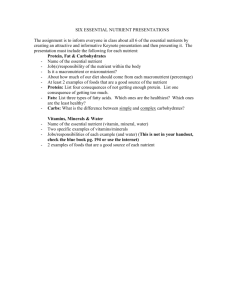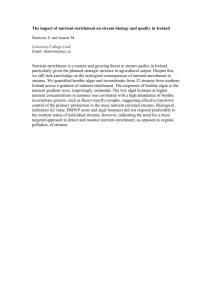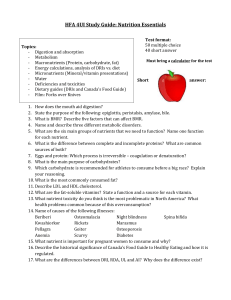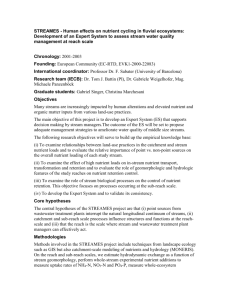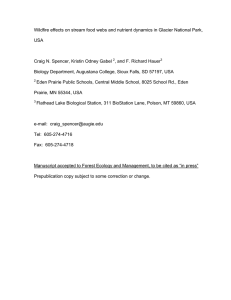Nutrient Limitation of Periphyton in Western Wisconsin Streams Shane Symmank
advertisement
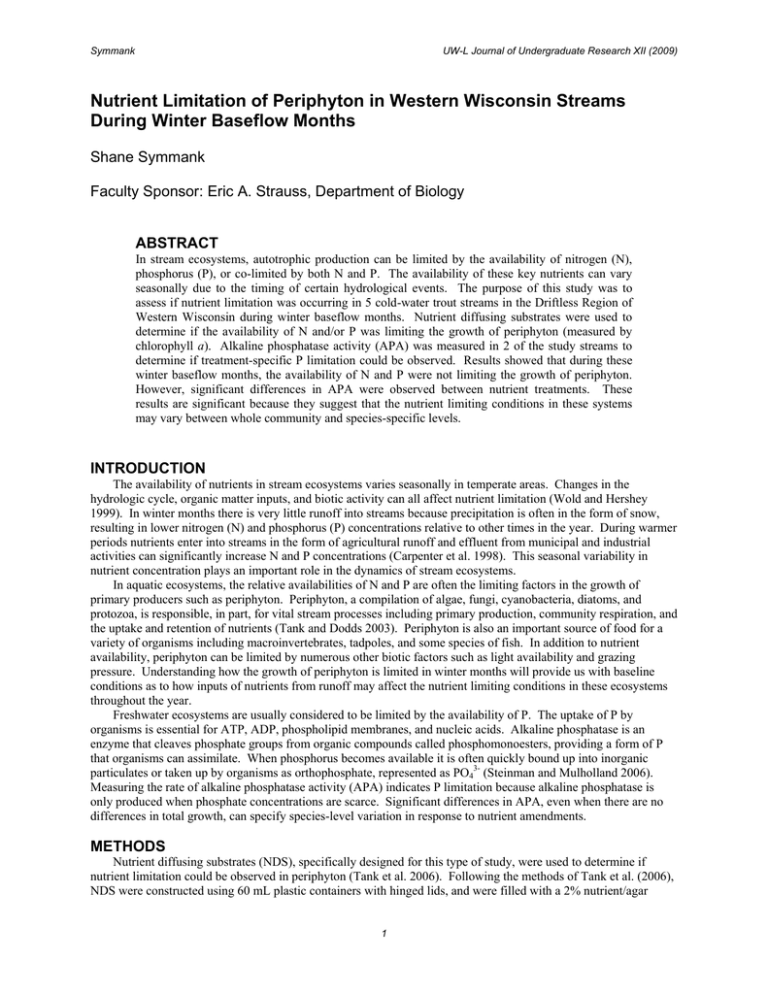
Symmank UW-L Journal of Undergraduate Research XII (2009) Nutrient Limitation of Periphyton in Western Wisconsin Streams During Winter Baseflow Months Shane Symmank Faculty Sponsor: Eric A. Strauss, Department of Biology ABSTRACT In stream ecosystems, autotrophic production can be limited by the availability of nitrogen (N), phosphorus (P), or co-limited by both N and P. The availability of these key nutrients can vary seasonally due to the timing of certain hydrological events. The purpose of this study was to assess if nutrient limitation was occurring in 5 cold-water trout streams in the Driftless Region of Western Wisconsin during winter baseflow months. Nutrient diffusing substrates were used to determine if the availability of N and/or P was limiting the growth of periphyton (measured by chlorophyll a). Alkaline phosphatase activity (APA) was measured in 2 of the study streams to determine if treatment-specific P limitation could be observed. Results showed that during these winter baseflow months, the availability of N and P were not limiting the growth of periphyton. However, significant differences in APA were observed between nutrient treatments. These results are significant because they suggest that the nutrient limiting conditions in these systems may vary between whole community and species-specific levels. INTRODUCTION The availability of nutrients in stream ecosystems varies seasonally in temperate areas. Changes in the hydrologic cycle, organic matter inputs, and biotic activity can all affect nutrient limitation (Wold and Hershey 1999). In winter months there is very little runoff into streams because precipitation is often in the form of snow, resulting in lower nitrogen (N) and phosphorus (P) concentrations relative to other times in the year. During warmer periods nutrients enter into streams in the form of agricultural runoff and effluent from municipal and industrial activities can significantly increase N and P concentrations (Carpenter et al. 1998). This seasonal variability in nutrient concentration plays an important role in the dynamics of stream ecosystems. In aquatic ecosystems, the relative availabilities of N and P are often the limiting factors in the growth of primary producers such as periphyton. Periphyton, a compilation of algae, fungi, cyanobacteria, diatoms, and protozoa, is responsible, in part, for vital stream processes including primary production, community respiration, and the uptake and retention of nutrients (Tank and Dodds 2003). Periphyton is also an important source of food for a variety of organisms including macroinvertebrates, tadpoles, and some species of fish. In addition to nutrient availability, periphyton can be limited by numerous other biotic factors such as light availability and grazing pressure. Understanding how the growth of periphyton is limited in winter months will provide us with baseline conditions as to how inputs of nutrients from runoff may affect the nutrient limiting conditions in these ecosystems throughout the year. Freshwater ecosystems are usually considered to be limited by the availability of P. The uptake of P by organisms is essential for ATP, ADP, phospholipid membranes, and nucleic acids. Alkaline phosphatase is an enzyme that cleaves phosphate groups from organic compounds called phosphomonoesters, providing a form of P that organisms can assimilate. When phosphorus becomes available it is often quickly bound up into inorganic particulates or taken up by organisms as orthophosphate, represented as PO43- (Steinman and Mulholland 2006). Measuring the rate of alkaline phosphatase activity (APA) indicates P limitation because alkaline phosphatase is only produced when phosphate concentrations are scarce. Significant differences in APA, even when there are no differences in total growth, can specify species-level variation in response to nutrient amendments. METHODS Nutrient diffusing substrates (NDS), specifically designed for this type of study, were used to determine if nutrient limitation could be observed in periphyton (Tank et al. 2006). Following the methods of Tank et al. (2006), NDS were constructed using 60 mL plastic containers with hinged lids, and were filled with a 2% nutrient/agar 1 Symmank UW-L Journal of Undergraduate Research XII (2009) mixture of either control (no nutrients), +N, +P, or +N+P. The nutrient/agar mixture was topped with a fritted glass disc, which acted as a means for the nutrients to diffuse out of the agar and into the water creating a nutrient specific microhabitat for periphyton to colonize and grow. Each NDS was capped with a hinged lid that had a hole of known area drilled through it. The NDS were tied to plastic L-bars and secured to the streambed using 3/8” rebar for 18-22 days. After the incubation period the fritted glass discs were collected, and the chlorophyll a concentration (µg/cm2) was determined spectrophotometrically. APA was measured using the enzyme labeled fluorescence method (Steinman and Mulholland 2006). RESULTS AND DISCUSSION A single factor analysis of variance showed no statistically significant (P < 0.05) nutrient limitation in 4 of the 5 study streams (see Figure 1, below). This suggests that some factor other than nutrient availability was limiting the growth of periphyton during the winter months. The statistically significant difference in the +N treatment of the Upper Spring Coulee Creek dataset can’t be explained as nutrient limitation, however it can be theorized that it simply represents the potential for significant variance, which often occurs in these systems. Figure 1. Chlorophyll a on fritted glass discs in response to the four nutrient treatments incubated in five different streams in West-Central Wisconsin. Means + standard deviations are plotted and each bar represents N = 12 for each treatment at each site. Letters refer to comparisons of treatments at a site and bars with the same letter are not significantly different (ANOVA, P > 0.05). 2 Symmank UW-L Journal of Undergraduate Research XII (2009) The APA data showed statistically significant differences at both sites (see Figure 2, below). It’s expected that the APA should be the highest where P is the most limiting. This was observed at the Timber Coulee Creek site as the +N treatment was significantly higher than the other 3 treatments, and the +N+P treatment was significantly higher than the control and +P treatments. This response suggests that ambient P availability was near limiting concentrations and that added N forced P limitation. These results may also suggest that there were unique species of algae filling various niches in response to different nutrient treatments within the community. The Upper Coon Creek site showed a significant increase in the +N+P treatment, but no difference in the +N treatment from the control and +P treatment. This implies that this system was not limited by the availability of P, but that a change in relative nutrient availability in response to the +N+P treatment altered the periphyton community to a state of P limitation. Figure 2. Alkaline phosphatase activity of periphyton on the fritted glass discs in response to the four nutrient treatments incubated in five different streams in West-Central Wisconsin. Means + standard deviations are plotted and each bar represents N = 12 for each treatment at each site. Letters refer to comparisons of treatments at a site and bars with the same letter are not significantly different (ANOVA, P > 0.05). In conclusion, despite the data from the APA suggesting near P limitation, the data from the NDS exhibited evidence that these systems were not limited by nutrients during the winter. Because days are much shorter during the winter it’s possible that the growth of periphyton was limited by light availability. Research conducted using NDS on nearby stream systems during the summer of 2008 showed significant co-limitation at numerous sites. This means that the nutrient limiting conditions in these streams are variable, and could potentially be affected by nutrient inputs from seasonal changes in runoff and effluent. Further studies will focus on obtaining data from the same stream sites at various times throughout the year in order to observe the affect of seasonable variability on nutrient limitation. Delving further into the APA experiments will require species counts under a microscope to determine if there are indeed different species filling niches in the four nutrient treatments and producing varied amounts of phosphatase enzyme. ACKNOWLEDGEMENTS The assistance of Dustin Jacobson and Dr. Eric A. Strauss was much appreciated for their help in the lab and in the field. The research was funded by the UW-L Undergraduate Grants Program. REFERENCES Carpenter, S., N. F. Caraco, D. L. Correll, R. W. Howarth, A. N. Sharpley, and V. H. Smith. 1998. Nonpoint pollution of surface waters with phosphorus and nitrogen. Issues in Ecology 3:1-12. Steinman, A. D., and P. J. Mulholland. 2006. Phosphorus limitation, uptake, and turnover in benthic stream algae. Pages 187-212, In: F. R. Hauer and G. A. Lamberti (Eds.), Methods in Stream Ecology. Elsevier, Burlington, MA. Tank, J. L., M. J. Bernot, and E.J. Rosi-Marshall. 2006. Nitrogen limitation and uptake. Pages 213-238, In: F. R. Hauer and G. A. Lamberti (Eds.), Methods in Stream Ecology. Elsevier, Burlington, MA. Tank, J. L., and W. K. Dodds. 2003. Nutrient limitation of epilithic and epixylic biofilms in ten North American streams. Journal of Freshwater Biology 48:1031-1049. Wold, A. P., and A. E. Hershey. 1999. Spatial and temporal variability of nutrient limitation in 6 North Shore tributaries to Lake Superior. Journal of the North American Benthological Society 18(1):2-14. 3

